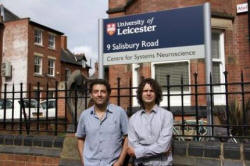|
 Total
recall: brain process for memory formation revealed Total
recall: brain process for memory formation revealed
 Send a link to a friend
Send a link to a friend
[July 02, 2015]
By Will Dunham
WASHINGTON (Reuters) - With a little help
from Clint Eastwood, Jennifer Aniston and Josh Brolin - or at least
photos of them - scientists have gained a new understanding of how
memories of everyday events are formed in the brain.
|
|
 Researchers said on Wednesday a study involving people with
electrodes implanted in their brains has shown that individual
neurons in a region called the medial temporal lobe play a central
role in swiftly forming these memories. Researchers said on Wednesday a study involving people with
electrodes implanted in their brains has shown that individual
neurons in a region called the medial temporal lobe play a central
role in swiftly forming these memories.
The study involved 14 people with severe epilepsy. They had
electrodes implanted to identify the brain location where their
seizures arose. The devices also enabled the researchers to pinpoint
individual neurons that encoded memories.
The subjects were shown about 100 pictures of celebrities including
Halle Berry, Julia Roberts, Tiger Woods, Aniston, Eastwood and
Brolin and places including the Eiffel Tower, Leaning Tower of Pisa
and White House.
The researchers identified individual neurons that fired to a
specific person, like Brolin, but not to a place, like the Eiffel
Tower, and created composite images of the person at that place.
 The subjects then were shown the composite images and the
researchers tracked the activity of individual neurons as the
patients processed new associations between people and places. The
individual neuron that earlier had responded to Brolin's image, for
example, immediately began responding to the Eiffel Tower as well.
"This study goes into the heart of the neural code underlying one of
the most fundamental aspects of human cognition and memory, namely
the formation of associations," said neurosurgeon Dr. Itzhak Fried
of Ronald Reagan UCLA Medical Center and the Geffen School of
Medicine at the University of California, Los Angeles.
"The astonishing finding was that this basic code is so explicit at
the level of individual neurons in the human brain," Fried added,
noting the researchers were able to record the activity of "one
lonely cell in a multitude of billions of neurons in the brain."
[to top of second column] |

Neuroscientist Rodrigo Quian Quiroga of the Centre for Systems
Neuroscience at Britain's University of Leicester said the findings
could be important for helping people with neurological diseases
like Alzheimer's.
"In order to understand and treat such pathologies it is always good
to understand how the normal brain process of forming and encoding
new memories works to then try to understand what may go wrong in
the pathology and how to potentially treat it," Quiroga said.
The research appears in the journal Neuron.
(Editing by Eric Walsh)
[© 2015 Thomson Reuters. All rights
reserved.]
Copyright 2015 Reuters. All rights reserved. This material may not be published,
broadcast, rewritten or redistributed.
 |